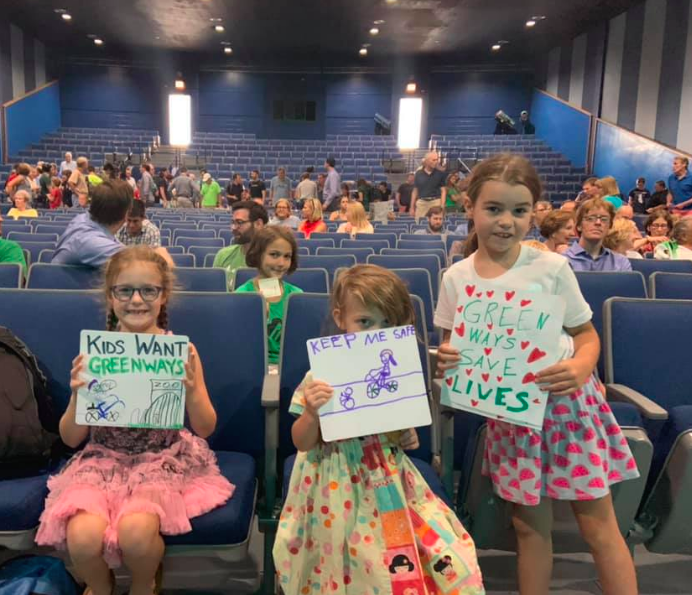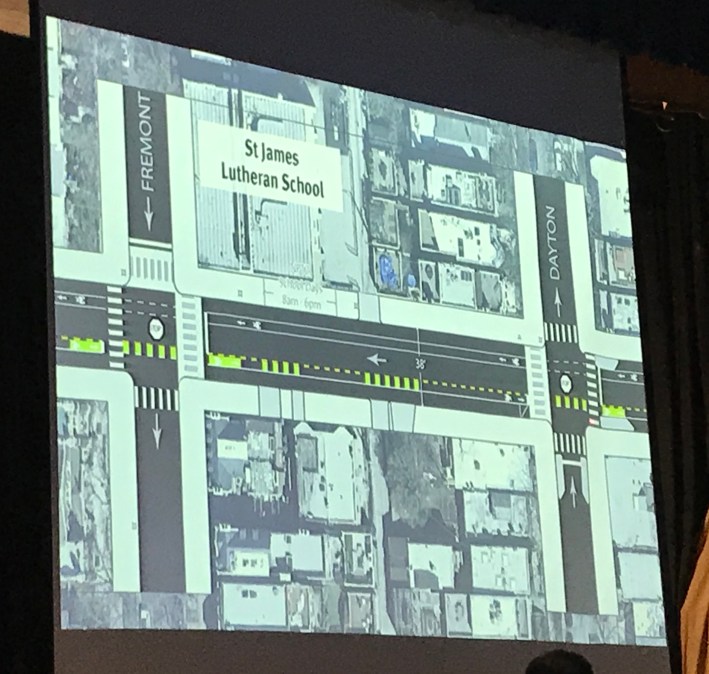Didn't have a chance to attend last night's meeting? You can fill out the Active Transportation Alliance’s petition in favor of the project.
I never did find out who sent the slick, anonymous mailings against the city's Dickens Avenue neighborhood greenway proposal and launched the Friends of Dickens NIMBY website, but at this point that info may be moot. Of the 100-plus people who packed the auditorium of Lincoln Park High last night for a community meeting on the family-friendly bikeway -- including plenty of children -- there seemed to be a clear majority of residents who support the project. This was evidenced by dozens of public comments praising the initiative, hundreds of petition signatures endorsing it, and scores of attendees wearing green to show their support.
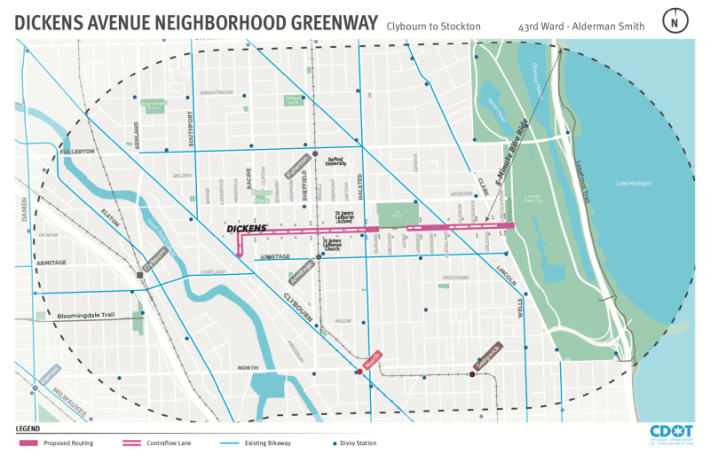
The Dickens Greenway project, which would include a contraflow bike lane to allow eastbound cycling on the one-way westbound street, would also feature a lower 20 mph speed limit, sidewalk extensions, speed humps, and raised crosswalks to calm motorized traffic and make walking safer and easier. But some neighbors blasted the proposed changes at a May 29 community meeting, indicating that they view increased bicycle traffic as a bigger safety threat to pedestrians than speeding drivers.
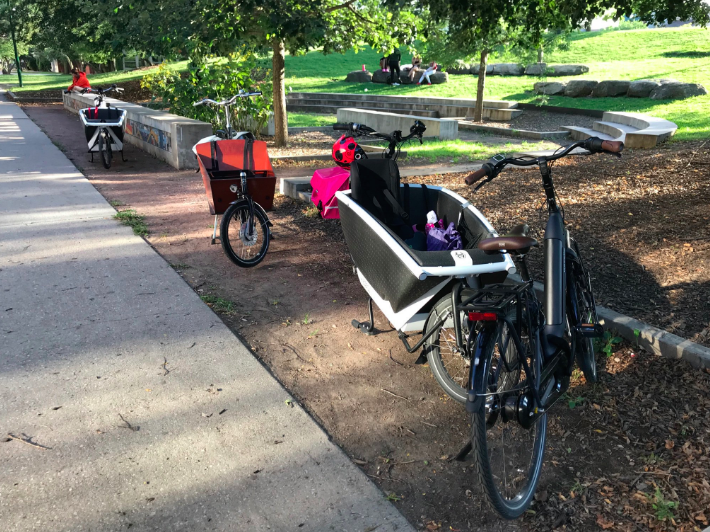
Chicago Family Biking, a grassroots organization with over 2000 members on its Facebook discussion group, did a great job of mustering its troops to attend last night's hearing. A dozen or two cycles were parked outside the school, including several Dutch-style kid-hauling box bikes. Inside the auditorium, the Chicago Department of Transportation had set up a long mock-up map of the proposed changes to the corridor, including updated renderings of the positions of the traffic-calming features. Attendees were invited to leave PostIts on the map with comments on the design.

Local alderman Michele Smith kicked off the meeting, stating that her office had received over 700 emails about the project since May, which they had forwarded to CDOT. As such, transportation department planner Dave Smith, who spoke next, was armed with info to address the safety concerns of the anti-greenway contingent.
"I just ask that you listen to [my] presentation, and come at it with an open mind," Smith said to the audience and, to their credit, the response from bikeway skeptics was generally more civil than it was during the contentious May meeting.
Smith addressed the concerns that the greenway will result in an epidemic of bike/pedestrian injury crashes, including injured kids. He said he has discussed the subject with the Chicago Department of Public Health, the local 18th Police District, and the Chicago Police Department's citywide Major Accidents crash investigation unit. "Everybody acknowledges that crashes between bicyclists and pedestrians do happen, but they are in very small numbers, and the risk of being seriously injured does not compare to the risk when a pedestrian gets hit by a car [drivers.]
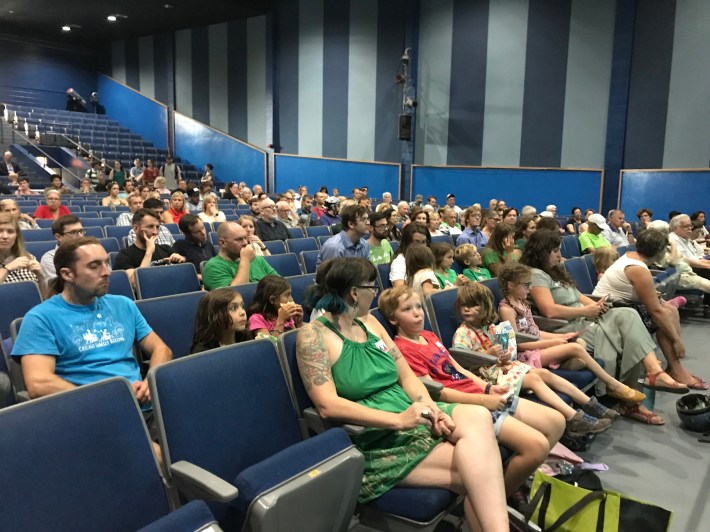
He added that the pediatric injury research department of Lurie Children's Hospital has agreed to work with CDOT to monitor all injury crashes to children 15 and younger in the area and let the city know how those crashes are happening. "I hope this will provide comfort for folks here today."
Smith noted that the Dickens Greenway would offer a lower-stress cycling alternative to the bike lanes on nearby Armitage Avenue -- a busy retail street with CTA buses, frequent truck deliveries and parking turnover -- and would better organize Dickens to encourage more predictable behavior from all road users. The department has found that Armitage has more than four times the traffic volume of Dickens, with 19 times as many drivers breaking the 30 mph speed limit, including some going as fast as 50. Smith noted that studies show that people struck by drivers doing 20 mph almost always survive, while those struck at 40 almost always die.
As for bike traffic, CDOT found that while Armitage currently sees four times as many cyclists as Dickens, none of the cyclists observed were children, while 11 percent of Dickens riders were kids. He added that 40 percent of cyclists on Dickens were riding eastbound against traffic, arguing that "there's a need to formalize this behavior" and make it safer and more predictable by adding the contraflow bike lane.
Smith noted that while the number of cyclists has increased on older neighborhood greenways with contraflow lanes, the total number of crashes decreased significantly. On Berteau and Wood streets, total crashes fell by 15 and 38 percent, respectively. He added that the number of women and children on bikes increased on streets that received greenways, drawing a round of applause.
Next Smith outlined the nuts and bolts of the Dickens project, which would include 27 new high-visibility zebra-striped crosswalks, 45 concrete curb extensions, five raised crosswalks, and five bike-friendly sinusoidal speed humps. More curbside drop-off space would be created at St. James Lutheran School, and raised crosswalks would be constructed at both nearby intersections.
Smith said CDOT has also received multiple requests to improve the Dickens/Cleveland/Lincoln intersections. The plan calls for bump-outs to shorten crossing distances, plus green bike lanes to shepherd cyclists across the six-way junction.
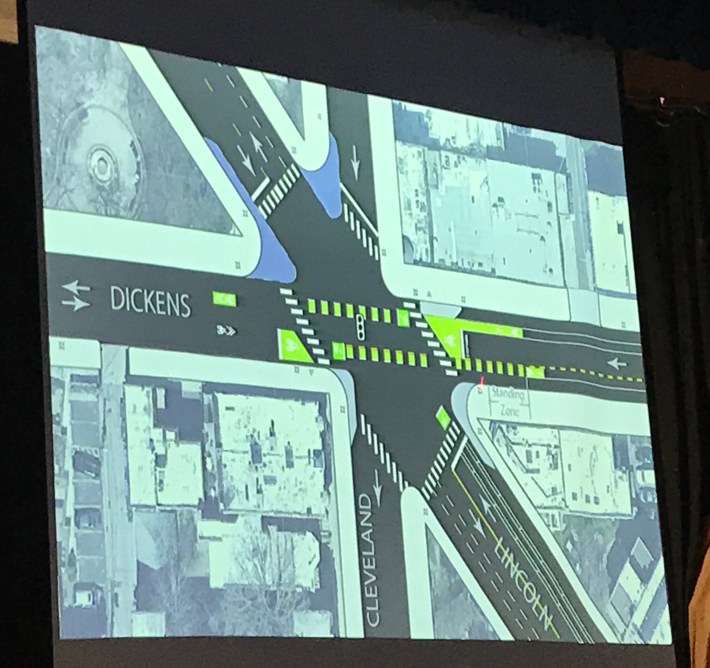
Addressing concerns about Oz Park, Smith said CDOT considered residents' requests to detour cyclists around the park via Armitage or Webster, but concluded that it's unlikely cyclists would use such circuitous routes. "People will continue to ride through the park as they do today."

The plan includes more than doubling the current number of bike parking spots in the park from 44 bikes to 92 by installing dozens of new racks, focusing on the southeast corner of the green space, which has none. Smith said racks would be strategically installed at Dickens and Howe Street, where cyclists enter the park, to direct bike riders onto a dedicated bike entrance to the multiuse path, "communicating that you are entering a shared space and to slow down."
He noted that while residents have argued that the concrete path is too narrow for more bike traffic, it's 14', four feet wider than the 10' national standard minimum for multiuse trails, and it also includes a four-foot-wide soft-surface path for runners, for a total width of 18'. Smith added that further widening the trail would require cutting down several trees.

Smith concluded by saying that CDOT would collect all feedback from the meeting, post the presentations on the 43rd Ward website, collect and review any additional input, make a final recommendation on the design in the coming months.
Dozens of people lined up to provide testimony at the meeting, a process that took about two hours. Local resident Gary Sinclair said he's concerned that the greenway will encourage more people to use Oz Park, which he argued is already overtaxed. Siouxzi Donnelly from Chicago Family Biking countered that the green space is "a great Chicago park that belongs to the entire city." She added that having safe on-street bikeways provides an opportunity for kids to learn proper cycling behavior without endangering themselves or people on sidewalks.
Biking dad Andrew Berg said he was sympathetic to the concerns of the bikeway opponents, but noted that data shows that they aren't realistic. "Don't scare the Dickens out of our greenway," he exhorted. "We need greenways so that when people make mistakes on the street, no one dies."
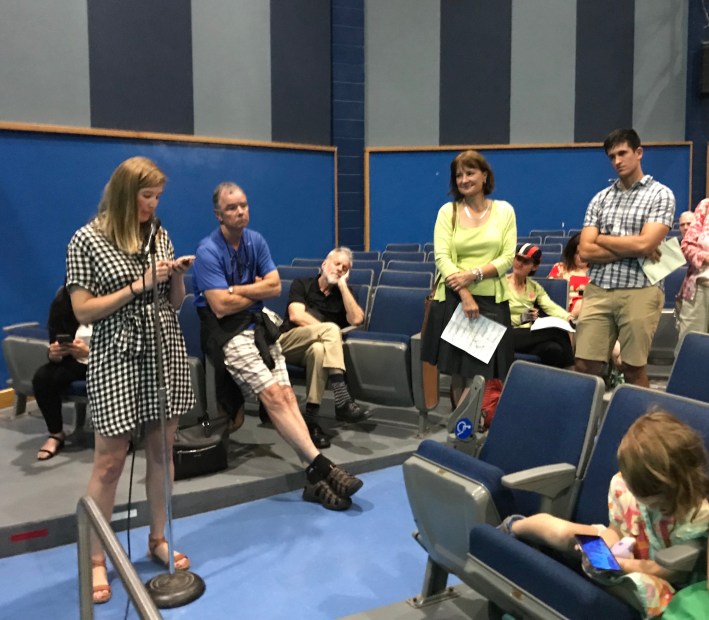
The president and vice president of the Oz Park Advisory Council said the group is opposing the project because they feel it's unsafe to have increased bike traffic through the park, stating that they had collected 232 signatures against the plan from park users and residents at nearby senior housing. But local neighbor Stephanie Simms, an expectant mom, said proponents have collected over 300 signatures in favor of the project. "It will make [pedestrians and cyclists] more visible, for my safety, my family's safety, and my community's safety."
A local man who rents space via Airbnb made a passionate speech decrying the NIMBY opposition:
I can appreciate that the greenway is a very controversial topic for many of the homeowners on Dickens. The idea that an underused street might become a shared community resource is certainly different thinking. I can even appreciate initial concern around safety, although it's becoming hard to understand how a project for safety, in this case a bike path, could ever be considered a bad idea. The tortured logic is instructive. It tells us that this discussion has moved past the realm of objectivity and into the realm of values. I view the outcome of this proposal as a vote on our values.
So what do we value? Do we value the freedom to travel safely by bike, foot, bus, or car? Do we value our neighbors and their children, who may choose to commute differently than us? Do we value our role as a gateway to Chicago's lakefront and the city's best institutions? And while few here will speak out against inclusivity, the tone of entitlement can not be obfuscated. It's the concept of keeping bikes on Armitage and not my street. "Don't mind the experts; this bike path is dangerous." And per [Friends of Dickens], presumably speaking on behalf of residents on the South and West sides, that they might be better off by decreased access to the Lincoln Park Zoo, the conservatory, the nature museum, the history museum, and broader lakefront.
So I simply ask the room to consider: Which Lincoln Park do you think our community most identifies with? One of safety, inclusion, ambassadorship, and common sense? Or one of fear and special interests, and a belief in segregation on who deserves safe access to our community?
The speech was met with thunderous applause from greenway supporters.
However, longtime neighborhood resident MaryAnne Spinner wasn't impressed. She said she lives near Armitage and Lincoln, which both have bike lanes, "so we are about to be hemmed in by bikers."
"I believe that bike riders are a special interest," Spinner said, alluding to the Airbnb owner's speech. "You think you have the moral imperative, but there are other people in the vicinity... Why are we always focusing on bike routes? According to CDOT there are 248 miles of bike lanes in this city already, thanks to our two previous mayors, who were both bikers." Another attendee later pointed out that Chicago has thousands of miles of car-dominated streets.
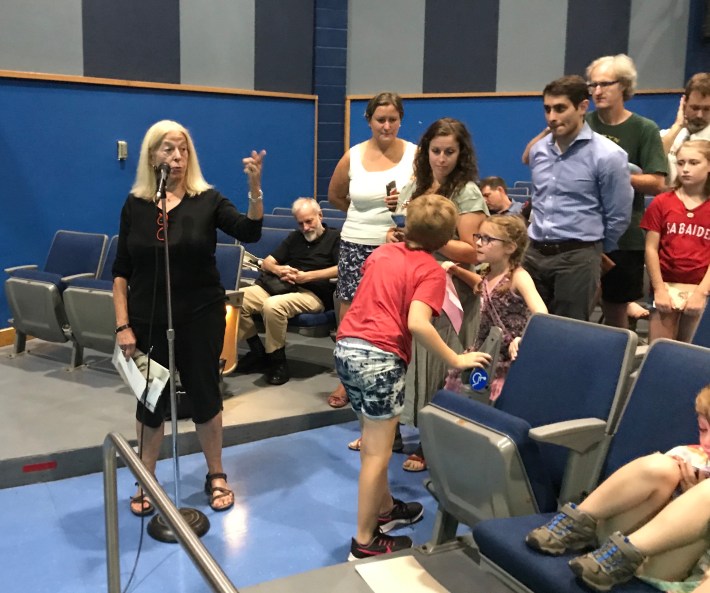
Spinner said "the gorilla in the room" was the cost of the greenway and the funding source, which CDOT hadn't yet disclosed. David Smith said the final price tag is yet to be determined, but $700,000 is a ballpark figure for the one-mile project, with 80 percent of the money coming from federal Congestion Mitigation and Air Quality Improvement funds, and the city paying the remaining 20 percent, or $140,000. He noted that the latter sum would only cover repaving about two blocks of Dickens, or purchasing one half of a single traffic signal, so the greenway is "a very cost-effective project."
Perhaps most problematically, two people who described themselves as "avid bikers" (often a red flag) argued that the facility would be unnecessary and unsafe. One man who characterized himself as a "professional cyclist" said he rides on Armitage all the time and can't imagine why anyone would feel unsafe biking there. Maybe because they're not professional cyclists?
The other anti-greenway bike enthusiast, who stepped up to the mic holding a helmet and a pannier, said the curb bump-outs along the Dickens corridor would be a hazard for cyclists, even though the CDOT plans clearly show the bike lanes wouldn't overlap with these sidewalk extensions. She added that contraflow bike lanes are unsafe, although she later admitted that she didn't recall ever riding in one of Chicago's many existing neighborhood greenways with contraflow lanes, so she had no experience with this kind of facility.
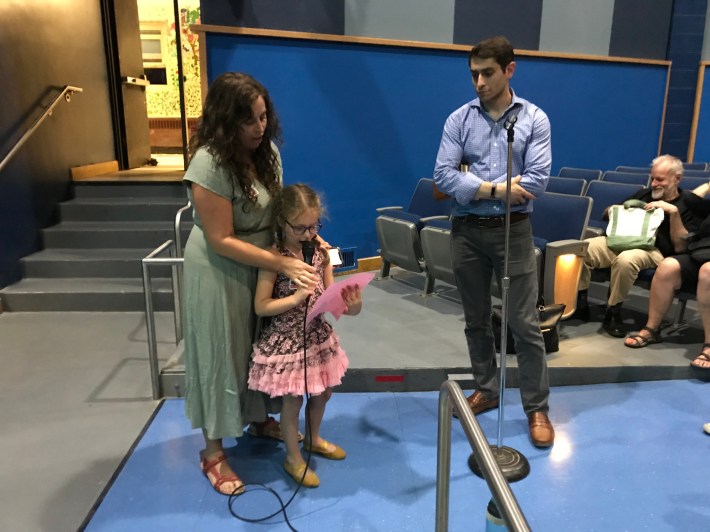
Rebecca Resman from Chicago Family Biking said she can't afford to live in Lincoln Park, but frequently cycles through the neighborhood with her children on their way to lakefront attractions. "Not building the greenway jeopardizes our children," she said. Resman added that drivers have twice injured her on her bike, including one who doored her she was pregnant with her daughter Sloane, now 6. "She was involved in a bicycle crash before she was born."
Sloane Resman read an eloquent statement in favor of the greenway herself. "My family is car-free and we get around our neighborhood on our family bike. My mom says we are getting too big and we will need to ride our own bikes soon. I'm scared to ride on the big streets to get to the zoo and Oz Park. I hope they make the new bike lane. It will be super for me, super for my little brother Max, and super for everyone."
Fill out the Active Transportation Alliance’s petition in support of the Dickens Greenway project.
